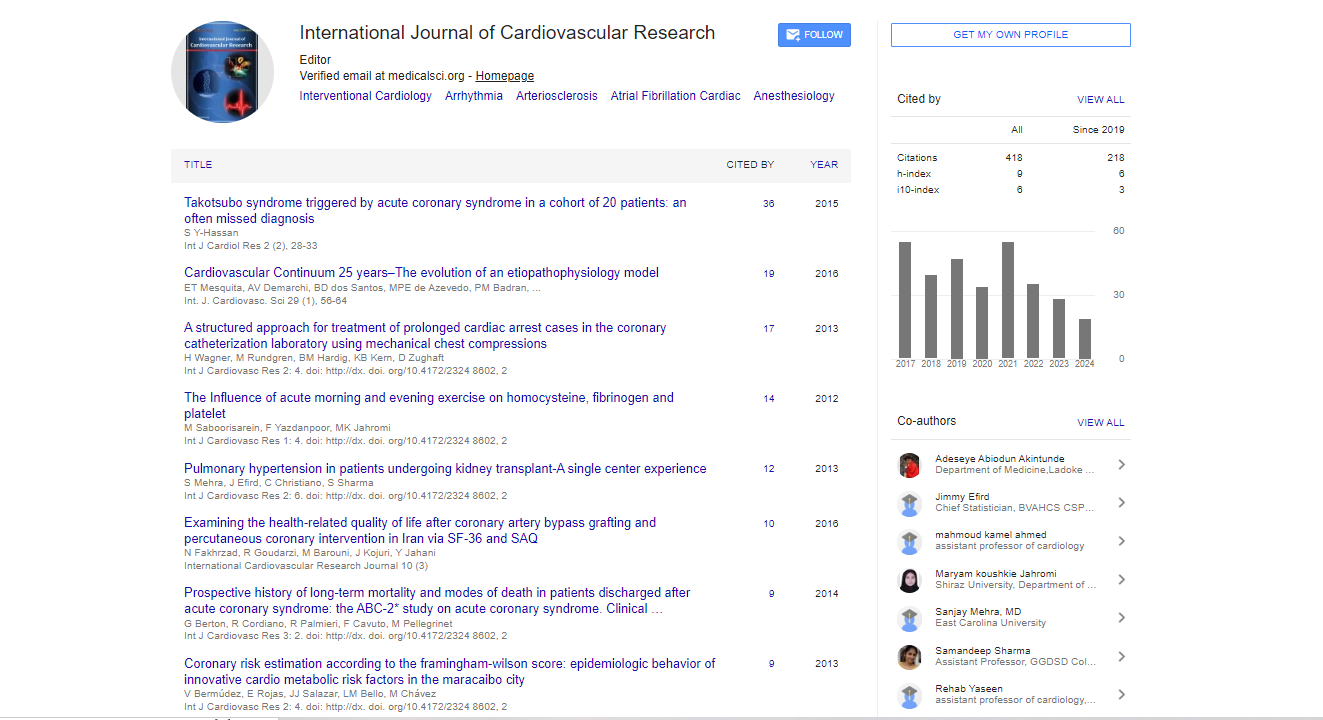Commentary, Int J Cardiol Res Vol: 13 Issue: 5
Technological Advances in Cardiovascular Surgery
Laura Martin*
1Department of Cardiovascular Medicine, University of Oxford, Oxford, United Kingdom
*Corresponding Author: Laura Martin,
Department of Cardiovascular Medicine,
University of Oxford, Oxford, United Kingdom
E-mail: laura.martin@gmail.com
Received date: 23 September, 2024 Manuscript No. ICRJ-24-153192;
Editor assigned date: 25 September, 2024, PreQC No. ICRJ-24-153192 (PQ);
Reviewed date: 09 October, 2024, QC No. ICRJ-24-153192;
Revised date: 16 October, 2024, Manuscript No. ICRJ-24-153192 (R);
Published date: 23 October, 2024, DOI: 10.4172/2324-8602.1000581.
Citation: Martin L (2024) Technological Advances in Cardiovascular Surgery. Int J Cardiol Res 13:5
Description
Cardiovascular surgery has undergone significant transformation over the past few decades, driven by continuous advancements in medical technology. Innovations ranging from minimally invasive techniques to robotic assisted surgeries, enhanced imaging technologies and improved biomaterials have revolutionized the field, leading to better patient outcomes, reduced recovery times and expanded possibilities for treatment. Minimally Invasive Surgery (MIS) has become one of the most significant advancements in the field of cardiovascular surgery. Traditional open-heart surgeries, which involve large incisions, prolonged recovery periods and higher risks of complications, have been increasingly replaced by less invasive techniques. MIS involves smaller incisions, reduced trauma to surrounding tissues and a quicker recovery time. One of the most widely used minimally invasive techniques in cardiovascular surgery is Endoscopic Coronary Artery Bypass Grafting (ECABG), which allows surgeons to bypass blocked coronary arteries using small incisions and specialized tools. The benefits of ECABG include shorter hospital stays, reduced blood loss and faster recovery times, making it a preferred option for many patients with coronary artery disease. Another important MIS procedure is minimally invasive valve repair or replacement, which can be performed through small incisions or even via catheter-based approaches. These techniques have gained popularity for treating patients with mitral or aortic valve diseases, allowing for faster recovery and a lower risk of infection compared to traditional open-heart surgeries.
Technological advancements in imaging have played an important role in improving both the diagnosis and execution of cardiovascular surgery. High-resolution imaging technologies such as Computed Tomography (CT) scans, Magnetic Resonance Imaging (MRI) and 3D echocardiography provide surgeons with detailed, real-time images of the heart and surrounding structures. These technologies enable more precise preoperative planning, allowing for better understanding of the patient's unique anatomy and the potential risks involved in surgery. Intraoperative imaging, including intraoperative CT and fluoroscopy, further enhances the surgeon’s ability to visualize the heart and blood vessels during surgery. This is particularly important in complex surgeries, such as aortic aneurysm repairs or valve replacements, where precise placement of grafts or prosthetic valves is important for success. Enhanced imaging also reduces the risk of complications, as surgeons can make adjustments during the procedure based on realtime data. Another breakthrough in imaging technology is the use of 3D printing to create models of the patient's heart. These models allow surgeons to simulate the surgery before actually performing it, helping to identify potential challenges and plan the most effective approach. Personalized 3D-printed models have shown assurance in reducing surgical errors and improving the overall safety of cardiovascular surgeries.
The development of biocompatible materials has had a profound impact on cardiovascular surgery, particularly in the field of prosthetics and grafts. Modern prosthetic heart valves, such as mechanical and tissue valves, are made from advanced materials that are both durable and compatible with the human body. These materials help to minimize the risk of rejection and reduce the need for longterm anticoagulation therapy, which is often required with older prosthetics. In addition to heart valves, biocompatible materials are used in vascular grafts, which are essential for bypass surgeries. The introduction of synthetic grafts, made from materials like expanded Polytetrafluoroethylene (ePTFE) or Dacron, has greatly improved the success rates of Coronary Artery Bypass Grafting (CABG) and peripheral artery surgeries. These materials are strong, flexible and resistant to infection, reducing the likelihood of graft failure and improving long-term patient outcomes. Moreover, advances in tissue engineering and regenerative medicine hold the potential to further enhance cardiovascular surgery. Researchers are analyzing ways to grow autologous tissues or even entire blood vessels in the laboratory, offering the possibility of using a patient’s own cells to create custom grafts or valves. This approach could eliminate the risk of rejection and reduce the need for immunosuppressive drugs after surgery.
Conclusion
The technological advances in cardiovascular surgery over the past few decades have significantly improved the outcomes for patients undergoing heart surgery. Minimally invasive techniques, roboticassisted surgery, enhanced imaging technologies, biocompatible materials and the integration of AI are all contributing to a new era of heart surgery characterized by precision, safety and faster recovery times. These innovations are not only changing the way surgeons approach cardiovascular disease but are also establishing the way for more personalized and effective treatments in the future.
 Spanish
Spanish  Chinese
Chinese  Russian
Russian  German
German  French
French  Japanese
Japanese  Portuguese
Portuguese  Hindi
Hindi 



